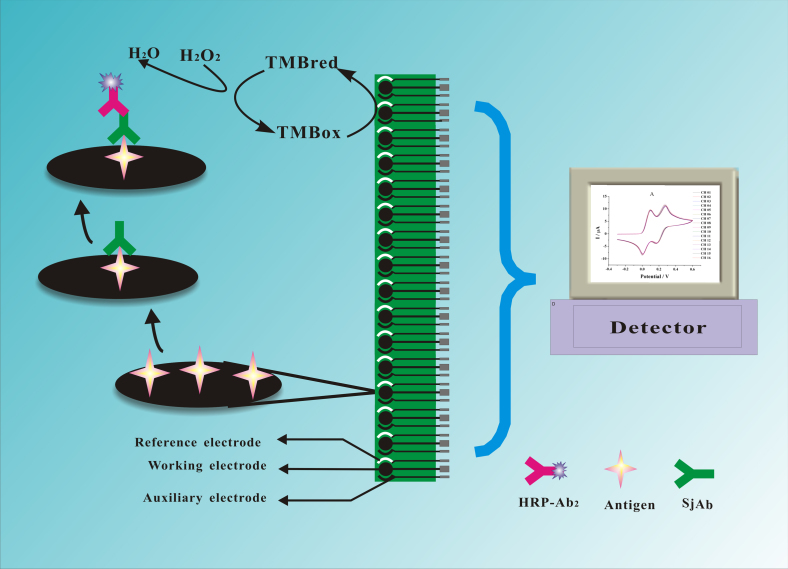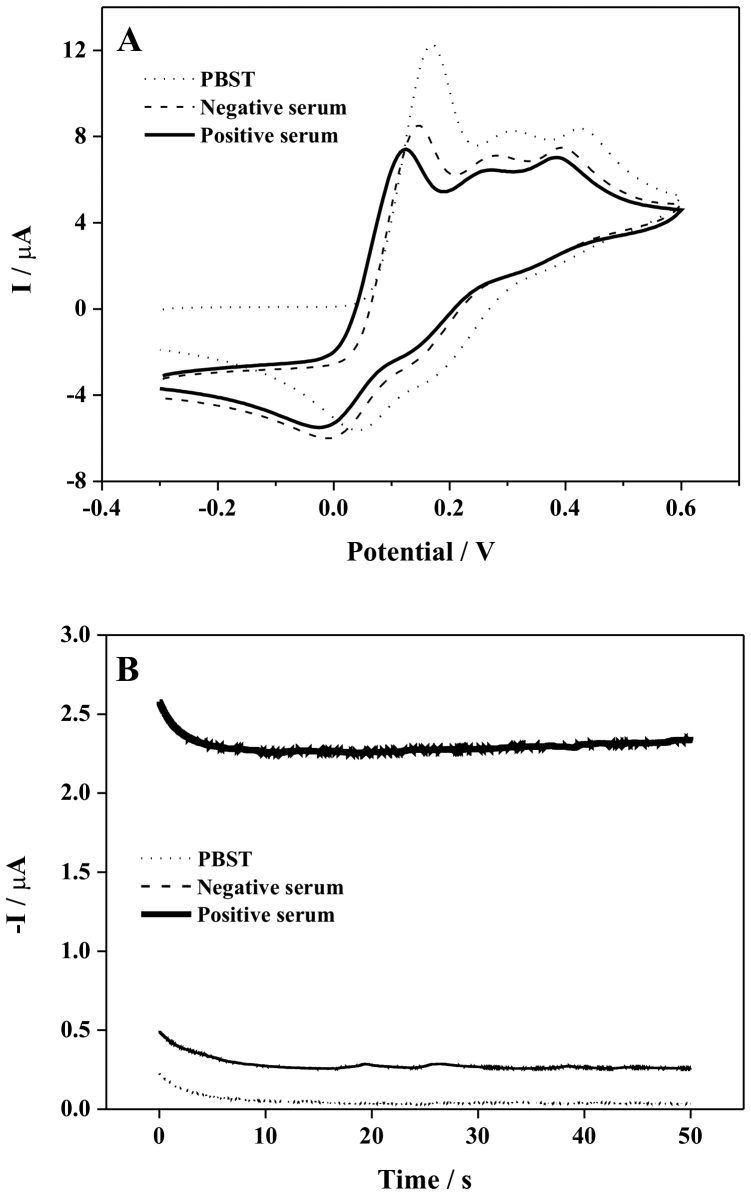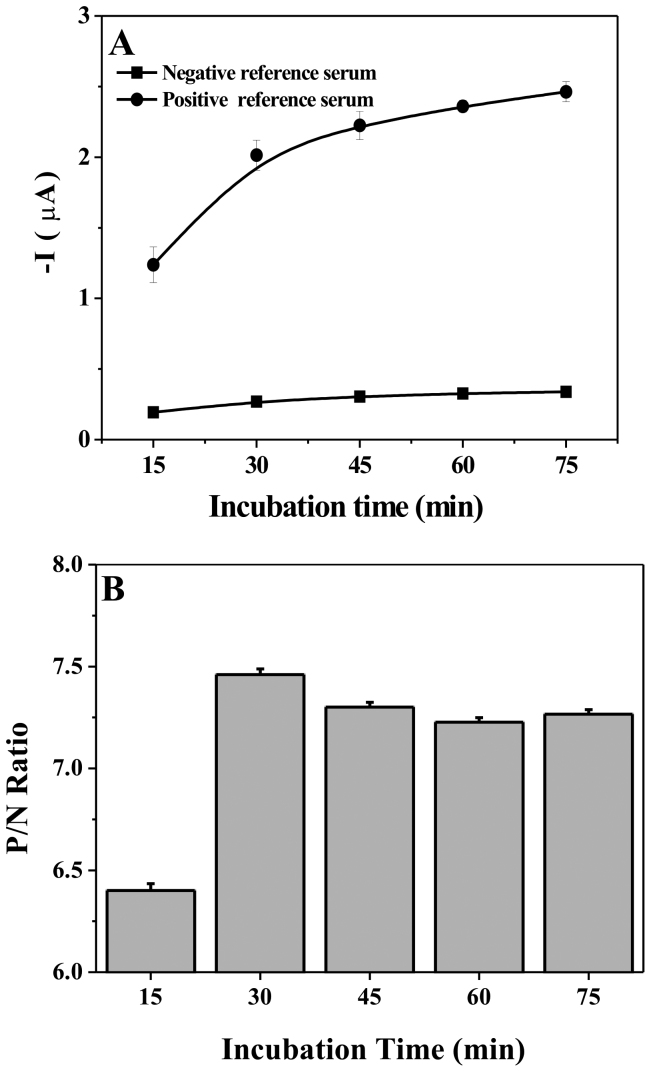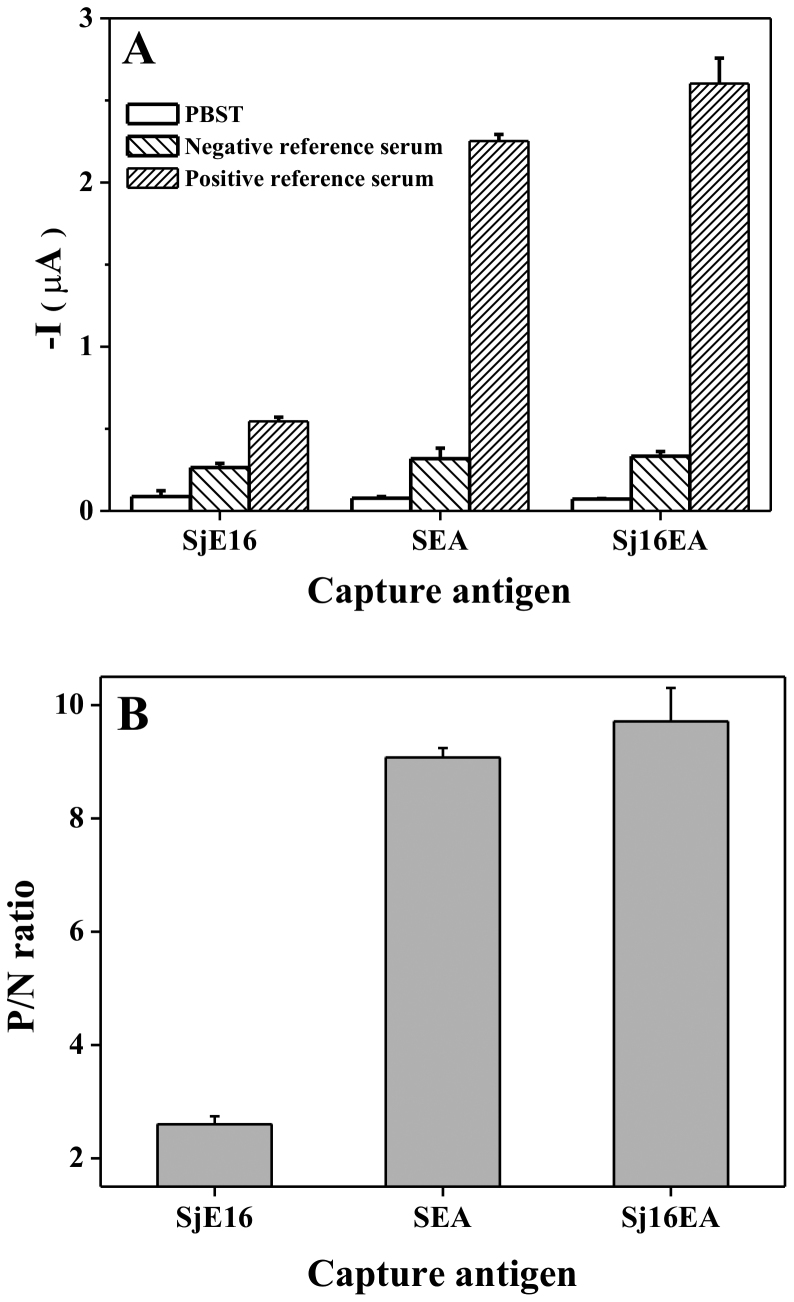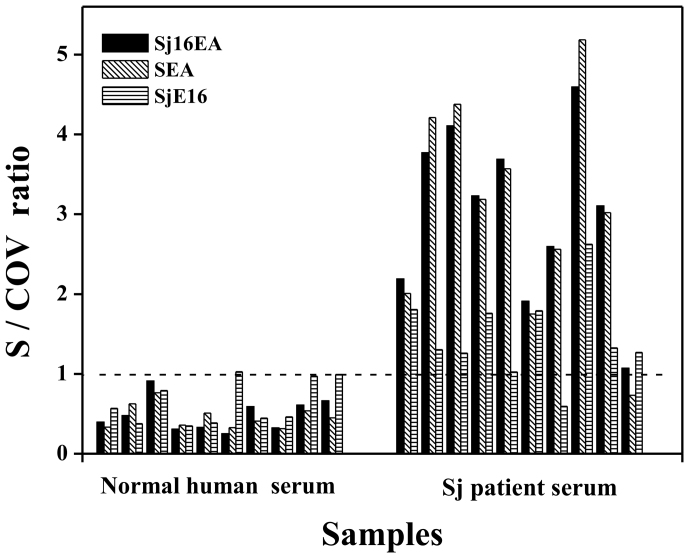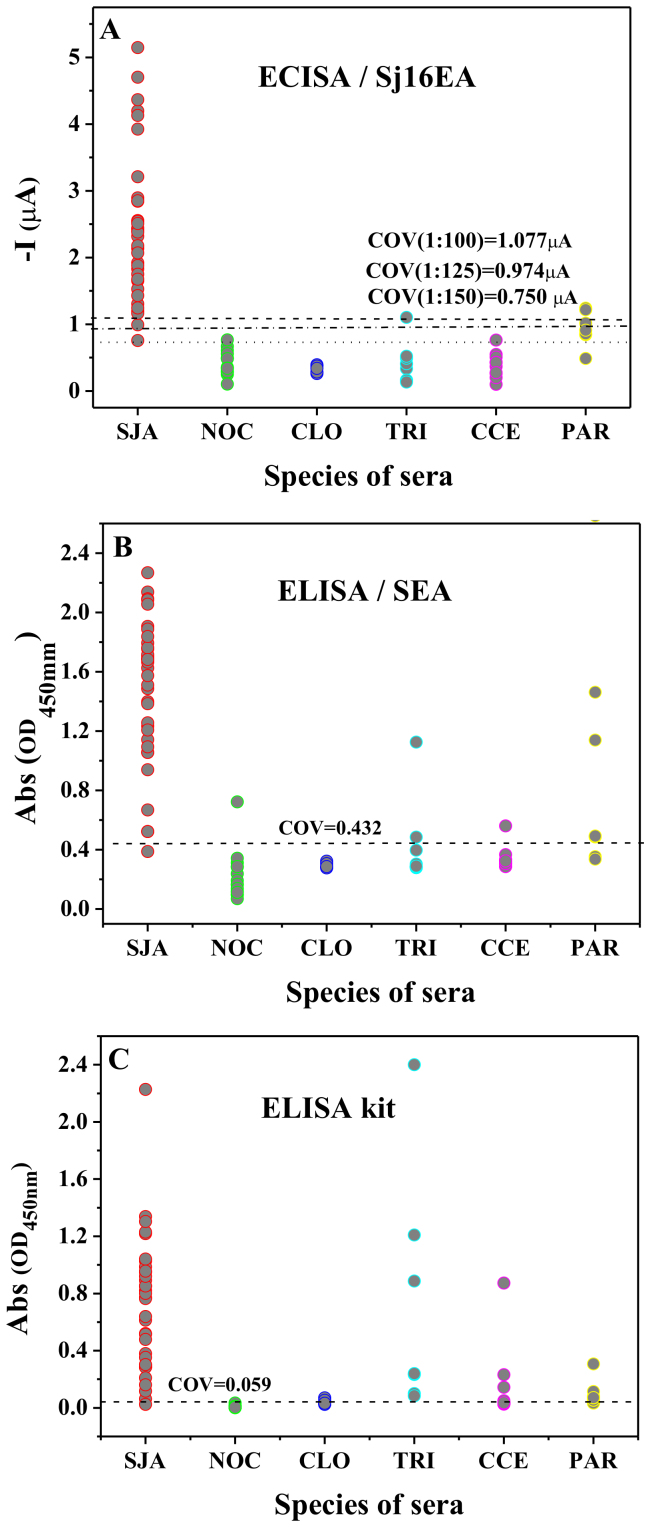Abstract
Schistosomiasis control remains to be an important and challenging task in the world. However, lack of quick, simple, sensitive and specific sero-diagnostic test is still a hurdle in the control practice. The commonly employed enzyme-linked immuno-sorbent assay (ELISA) relies on the native soluble egg antigen (SEA) that is limited in supply. Here we developed an electrochemical immunosensor array (ECISA) assay with an interfacial co-assembly strategy. A recombinant Schistosoma japonicum (Sj) calcium-binding protein (SjE16) was used as a principal antigen, while the SEA as a minor, co-assembling agent, with a ratio of 8:1 (SjE16: SEA, Sj16EA), which was co-immobilized on a disposable 16-channel screen-printed carbon electrode array. A portable electrochemical detector was employed to detect antibodies in serum samples. The sensitivity of ECISA reached 100% with minimal cross-reactions. Therefore, we have demonstrated that this rapid, sensitive and specific ECISA technique has the potential to perform large-scale on-site screening of Sj infection.
Schistosomiasis is one of the most prevalent parasitic diseases threatening more than 200 million people in 76 tropical and subtropical countries1. Schistosomiasis japonica (Sj) caused by infection of Schistosoma japonicum remains to be a major public health problem in China, and has significant economic and public health consequences2,3,4. Early and rapid diagnosis is the key to the effective control of Sj. All the sero-diagnostic reagents and kits for schistosomiasis reported are based on antibody (Ab) detection interpreted by visualizing the color reaction with naked eye or an absorbance reader. Detection of Sj antibodies with ELISA5,6,7,8 or indirect fluorescent antibody test (IFAT), and indirect hemagglutination assay (IHA), are commonly used methods for Sj diagnosis5,6,9,10 in China. However, these methods are still limited by their sensitivity5,11, complicated and time-consuming operation, and sophisticated instruments5,6 that largely hampers on-site large-scale screening of Sj. Therefore, it is necessary to develop rapid, simple and portable tests for Sj with high sensitivity and specificity. Another major problem associated with Sj detection lies in antigens that are employed to capture Sj antibodies. Commercially available ELISA kits for Sj rely on the use of crude soluble egg antigens (SEA). While such SEA-based kits are of high sensitivity, the specificity is often insufficient since, it is likely to contain host antigen or common antigenic component with other kinds of parasites5,6. Moreover, the cost of the native protein-based reagent is in increase remarkably due to the limited supply of infected snails. It is thus difficult to obtain the crude native antigen in large amounts12 and to control the quality, restricting its application in large-scale screening of schistosomiasis. To overcome such barricades, recombinant antigens (e.g., rSj32, rSj31, rSj26) have been developed to substitute SEA, however, their affinity with the Sj antibody (SjAb) is still limited, and the assays showed low sensitivity13,14,15,16.
In recent years, there has been growing interest in the development of electrochemical immunosensors for diagnostic assays, mostly because of the availability of low-cost and the small electrochemical detectors that are particularly suitable for field detection11,17,18,19,20,21,22,23,24,25. Previous efforts to develop electrochemical immunosensors for SjAb employed a 32-kDa S. japonicum adult worm antigen, and only tested with rabbit serum, not tested for the sensitivity, specificity and cross reaction of the sensors with human serum samples. In addition, the immobilization methods of the antigen on the single electrode transducer described in these reports are complicated, unsuitable for multiplex analysis of human serum samples26,27,28,29,30.
Here we report a novel portable multiplexing electrochemical immunosensor array (ECISA) for qualitative detection of SjAb in human serum. Screen-printing is a thick-film technology that can be applied for mass production of screen-printed carbon electrode (SPCE) array with very low cost and high reproducibility31,32,33,34,35. The antigens are immobilized on the interface of SPCE array to capture SjAb36,37,38. We developed a co-assembly strategy to immobilize both recombinant Schistosoma japonicum calcium-binding protein (SjE16) and SEA39,40 on SPCE arrays to improve the sensitivity and specificity and lower the cost. Such immunosensor array is transdued with a home-made electrochemical detector.
Results
The electrochemical performance of the SPCE array was evaluated with the redox activity of ferricyanide by CV with the 16-channel electrochemical device. The CV data (see supplemental Data Figure s3) showed that the relative standard deviation of oxidation peak voltage and oxidative peak current for 16 array measurements was 2.1% and 3.4%, respectively, indicating that the SPCE array and ECH16 are able to produce reproducible results.
We also carried out the CV measurements and amperometric measurements in TMB (3, 3′, 5, 5′ tetramethylbenzidine) test. Supplemental Data Figure s4A revealed a typical CV curve for TMB, exhibiting two pairs of characteristic redox peaks. The current versus time (I-T) curve was employed and the potential was held at −0.1 V according to the CV curve (Supplemental Data Figure s4B) to obtain reduction current of TMB on the surface of electrodes. The current increased with the scan time until stable state at 50 s. The CV and I-T curve of 16-channel SPCE array were nearly identical, indicating that the assay could produce accurate and reproducible results in the TMB-containing system.
Before the assembly of antigens, the electrochemical activation of all carbon working electrodes of SPCE array was made to generate carboxylate groups. We carried out the CV scan of SPCE in 0.01 M phosphate buffer (pH 7.2) by running 10 cycles with potential range from −0.3 to 0.6 V at a scan rate of 500 mV/s. The electrochemical activation was completed by oxidation-reduction reaction and the reproducible surface property of the SPCE array was shown directly by CV curve (Supplemental Data Figure s5).
The ECISA system adopted an indirect immunoassay configuration (Figure 1), which involved capture antigens immobilized on SPCE and HRP- Ab2 (detection probes) to form an immunocomplex with the target antibodies, leading to the binding of HRP to the electrode array. In this assay process, the redox activity of TMB containing H2O2, the substrate of HRP, induces the change of current on the electrodes, so that the immuno-reaction on the SPCE can be detected by measuring the reduction current at a certain potential with the 16-channel electrochemical detector. Qualitative discrimination of SjAb in negative reference serum and positive reference serum was carried out to test the feasibility of the ECISA. The PBST was used as the blank control. Figure 2A showed a typical CV curve for HRP performance on the SPCE which has three pairs of characteristic redox peaks. The CV curve also indicated that the antigens have been immobilized on the SPCE effectively. The amperometry measurement was employed for the determination of SjAb in serum while the potential was held at −0.1 V according to the CV curve. The I-T curve showed that the steady state current for positive reference serum containing SjAb was approximately 2.4 μA, while that for negative reference serum and PBST was only 0.25 μA and 0.04 μA, respectively (Figure 2B). The high P/N ratio (~10) between positive reference serum and negative reference serum demonstrates the capability of the immunosensor to distinguish schistosomiasis patient serum from normal human serum.
Figure 1. Schematic diagrams of ECISA for SjAb.
A portable ECH16 and disposable 16-channel SPCE array were employed as the assay system. The antibodies in the serum samples and the signal probe HRP-Ab2 formed an immunocomplex with the capture antigen on the working electrode, leading to the binding of HRP to the electrode that can be transformed to the catalytic amperometric readout.
Figure 2. The qualitative discrimination of SjAb with ECISA.
(A) Cyclic voltammograms (CV) curves for the detection of SjAb in PBST(short dashed line), negative reference serum (long dashed line)and positive reference serum (solid line) using ECISA. (B) Amperometric(I-t) curves for the detection of SjAb in PBST(short dashed line) negative reference serum (long dashed line)and positive reference serum (solid line) using ECISA.
The performance of the immunosensor array is also dependent on the incubation time in ECISA. Figure 3A showed the effects of incubation time on amperometric responses of SjAb detection in reference serum. With the increase of incubation time, the amperometric responses to SjAb in positive reference serum increased quickly in 30 min and become consistent at 45 min. However, the non-specific binding of negative reference serum was also in increase through the incubation time. Figure 3B showed that the P/N ratio achieved the highest at 30 min, which is the best timing for qualitative determination of SjAb in serum samples. Note, it often take more than one hour for the incubation of serum in ELISA. Moreover, electrochemical assay can be directly performed after the incubation step, unlike ELISA that often needs additional incubation with the substrate. Thus, ECISA is a rapid test method that takes only 1/3 time of that of ELISA41.
Figure 3. The response time of ECISA for SjAb assay.
(A) The effect of the serum incubation time on amperometric responses of SjAb detection in ECISA. (B) The effect of the serum incubation time on P/N ratio of SjAb detection in ECISA. The amperometric current shown on the above is the initial catalytic amperometric readout. The P/N ratio was calculated by deducting the background signal from serum diluents PBST.
We compare three assembling methods with the same immobilization time, including single antigens and two antigens. This involved SjE16 (250 ng), SEA (30 ng), and the Sj16EA,a mixture of SEA (30 ng) and SjE16 (250 ng). Figure 4 showed that the immunosensor array has the best positive responses and P/N ratio when the two antigens (Sj16EA) were used. The co-assembly of Sj16EA improves the positive signal and P/N ratio. Furthermore, we compared the effects of the three assembling strategies on the sensitivity and specificity of ECISA. Ten negative reference serum specimen and 10 positive reference samples were tested for the comparison. A 1:100 dilution was used for all serum specimens involved in ECISA with three immunosensor arrays. The ratio of signal read to cut off value (S/COV ratio) was shown in Figure 5. The sensitivity of Sj16EA, SEA and SjE16 was 100% (10/10), 90% (9/10) and 90% (9/10), respectively, while the specificity of Sj16EA, SEA and SjE16 was 100% (10/10), 100% (10/10) and 90% (9/10), respectively. The ECISA/Sj16EA has higher sensitivity than ECISA/SjE16 and ECISA/SEA, and its specificity is in agreement with ECISA/SEA. These data clearly showed that the co-assembly approach is superior to the immobilization with either single antigen in SjAb detection.
Figure 4. Comparison of three assembling strategies.
(A) The Amperometric responses and (B) P/N Ratio response to the PBST, negative reference serum and positive reference serum with three assembling strategies of capture antigen. SjE16: incubated with5 μl of 50 mg/L SjE16 for 2 h, SEA: incubated with 5 μl of 6 mg/L SEA for 2 h, Sj16EA: incubated with 5 μl mixture of 6 mg/L SEA and 50 mg/L SjE16 for 2 h.
Figure 5. Sensitivity and specificity comparison of three antigen immobilization strategies.
The Sj16EA, SEA and SjE16 were assembled on electrode arrays in the ECISA. The ratio of the sample signal to cut off value(S/COV ratio) is employed as y-axis because there are three different cut off values. The serum is considered positive when the S/COV ratio equal to or greater than 1.
The intra-assay variation and inter-assay variation of the immunosensor array were evaluated by 20 times of repeat detections for one lot of reference serum and 24 times of repeat detections for three lots of reference serum, respectively. The coefficient of variation of the intra- and inter-assay was 7.5% and 15.08%, respectively, indicating that the ECISA has reasonable repeatability and reproducibility. We also evaluated the stability of the immunosensor array. The immunosensor array was stored at 37°C through 16 days and the P/N ratio was measured at 0 d, 2 d, 4 d, 8 d and 16 d. At the 16 d, the signal of negative serum and positive serum kept consistent (see Supplemental Data Figure s6A), and the P/N ratio also remained consistent (see Supplemental Data Figure s6B). It was demonstrated that the immunosensor array has good storage stability and is suitable for practical applications. Also, ECISA/Sj16EA method has good dose-response effect for SjAb detection (Figure s7).
To demonstrate the assay performance of the new method, serum samples (35 schistosomiasis japonica, 5 clonorchiasis, 9 trichinosis, 10 cysticercosis and 7 paragonimiasis, 15 normal human sera as the control) were tested by ECISA and ELISA. With ECISA, all the serum specimens with three dilutions (1:100, 1:125 and 1:150) were tested for different COVs, while the ELISA was performed at a 1:100 dilution. Figure 6 showed the comparison results of ECISA, in-house ELISA and commercial ELISA.
Figure 6. Comparison of ECISA and ELISA for sensitivity, specificity and cross reaction in sera of individuals with schistosomiasis japonica (SJA), normal control (NOC), clonorchiasis (CLO), trichinosis (TRI), cysticercosis (CCE), paragonimiasis (PAR).
(A) Amperometric responses by ECISA/Sj16EA. COV (1:100) = 1.077 μA, COV (1:125) = 0.974 μA, COV (1:150) = 0.750 μA. (B) OD values at 450 nm by ELISA/SEA, COV = 0.413. (C) OD values at 450 nm by ELISA kit, COV = 0.059.
The results of statistic analysis were shown in Supplemental Data Table s1.When the COV resulted from the dilution of 1:100, 1:125 and 1:150, the sensitivity of ECISA was 94.3%, 97.1% and 100%, respectively, while its specificity was 100%, 100% and 93.3%, respectively. ECISA had no cross-reaction with clonorchiasis and cysticercosis. The cross-reactivity with trichinosis was 11%, and with paragonimiasis was 28.6%, 42.9% and 85.7% respectively. The sensitivity of ELISA/SEA and commercial ELISA kit was 97.1%, with a specificity of 93.3% and 100%, respectively. The cross-reactivity of ELISA kit with clonorchiasis, trichinosis, cysticercosis and paragonimiasis was 20%, 33.3%, 60% and 100%, respectively.
Discussion
Compared with ELISA, the ECISA using a quarter amount of SEA (120 ng for one test in home-made ELISA, but 30 ng in ECISA) showed improved sensitivity (100%) when the COV is defined at the dilution of 1:150. Even though the dilution of 1:125 was used to define the COV, ECISA has the sensitivity (97.1%) and specificity (100%) comparable with ELISA kit, more importantly, no matter what dilution is used for COV (1:100, 1:125 or 1:150), ECISA has much lower cross-reaction than ELISA. This should be attributed to the use of recombination antigen SjE16 and the decreased amount of SEA. For the latter, it likely has common antigenic component with other parasite species. Moreover, control experiments also showed the advantage of co-assembly of SjE16 and SEA in lowering the cross-reaction for ECISA method.
In summary, we developed an electrochemical immunosensor array ECISA technique, a sensitive, specific and rapid diagnostics by detection of SjAb using the disposable 16-channel SPCE array and an electrochemical detector. The immunosensor arrays were fabricated by co-assembly with recombinant SjE16 antigen and crude SEA antigen (8:1). Eighty one human serum samples were assayed by the ECISA, and the sensitivity reached up to 100% and specificity 93% with good reproducibility and stability. In comparison, although the sensitivity and specificity were comparable with ELISA, the amount of native antigen SEA was reduced at least by 75%, even much more when compared with the other ELISA methods reported39. Using recombinant antigen to largely replace the amount of native antigen used would helpful to overcome the imperfection of limited resource and the increasing cost for a long preparation process of native antigen in ELISA system. Moreover, the cross reaction of ECISA is lower than the ELISA, and it takes only about one hour for ECISA test processing, while ELISA usually about 3 hours. Given that both electrochemical detectors and SPCE arrays are of low cost and portable in size, and the assay would be much easier and quicker when a computer program is set to directly output the diagnostic advice, the ECISA may provide a new feasible tool for on-site large-scale screening of schistosomiasis.
Methods
Apparatus
Cyclic voltammetry (CV) measurement and amperometric measurement of ECISA were performed with a portable home-made 16-channel electrochemical detector (ECH16), which is connected to a computer (See Supplemental Data Figure s1 for more details). The disposable 16-channel SPCE array was shown in Supplemental Data Figure s2. Each electrode consists of a carbon working electrode (3 mm diameter), a carbon auxiliary electrode, and an Ag/AgCl reference electrode. An insulating layer is printed around the working area to constitute a reservoir of the electrochemical microcell. The ELISA was measured with a Tecan GENios microplate reader at room temperature.
Reagents
The ELISA kit employed in the study was purchased from Shenzhen Combined Biotech Co., Ltd (Shenzhen, China). The antigen SjE16 and SEA were prepared as described39,40. The negative reference sera, positive reference sera, 15 normal human sera, 35 schistosomiasis sera, 5 clonorchiasis sera, 9 trichinosis sera, 10 cysticercosis sera, and 7 paragonimiasis sera were all provided from the National Institute of Parasitic Diseases, Chinese Center for Disease Control and Prevention. Written informed consents of all donators were obtained and approval was received for our study from the local Ethics Committee on Human Research.
The substrate TMB ( Neogen K-blue low activity substrate) was purchased from Neogen (Lansing, US). Ferricyanatum Kalium, HRP labeled goat anti-human IgG (HRP-Ab2), BSA, Tween-20, 1-(3-(dimethylamino)-propyl)-3-ethylcarbodiimidehydrochloride (EDC), and Nhydroxysulfosuccinimide (NHS) were from Sigma-Aldrich (St. Louis, US). The buffer solutions involved in this study are as follows: The antigen was dissolved in 0.01 M phosphate saline (PBS) buffer (0.01 M phosphate, pH 7.2, 0.14 M NaCl, 2.7 mM KCl). The PBST (0.5‰ tween-20 in 0.01 M PBS) was used as washing buffer, and the 0.01 M PBS buffer with 1% BSA as the Blocking buffer. The buffer for electrochemical measurement was TMB substrate. EDC and NHS were dissolved in water immediately before use. All solutions were prepared with doubly distilled grade water from a Millipore system.
Fabrication of immunosensor arrays
The electrochemical performance of the SPCE array was evaluated for the redox activity of ferricyanatum kalium and TMB by CV and amperometric measurement with in-house built ECH16. The measurement for ferricyanatum kalium were performed in a 5 mM K3 [Fe (CN)6] contained in 0.1 M KCl by cyclic voltammetric scanning for 2 segments at the potential window of −0.5 to 0.6 V. The measurement for TMB was performed by cyclic voltammetric scanning for 2 segments at the potential window of −0.3 to 0.6 V and amperometric measurement at the voltage of −0.1 V for 50 seconds. The SPCE arrays were pretreated electrochemically to generate the carboxylic acid groups on the working electrode by running CV with the 16-channel electrochemical detector. The activation was carried out in a 0.01 M phosphate buffer (pH 7.2) by running 10 cycles of CV with potential window of −0.3 to 0.6 V at the scan rate of 0.5 V/s. Then, 10 μL of freshly prepared 400 mM EDC and 100 mM NHS in water was placed on to the working electrodes to activate carboxylic acid groups, and washed off after 15 min. This was immediately followed by 2 h incubation at room temperature with 5 μL mixture of 6 mg/L SEA and 50 mg/L SjE16 (controls: 5 μL of 6 mg/L SEA; 5 μL of 50 mg/L SjE16 antigen). Thus, the capture antigens were immobilized on the working electrode by the binding of amine residues on the proteins to the carboxy groups of working electrode. After rising with ddH2O, each electrode was then incubated for 1 h at room temperature with 50 μL of blocking buffer to block any nonspecific binding sites on the SPCE. Finally, the immunosensor arrays were stored in 4°C ready for use. The negative reference serum and positive reference serum were employed in the assay to evaluate the performance of the arrays. The positives, negatives and the ratio of positive to negative (P/N ratio) was recorded in the computer to evaluate the sensitivity and specificity of the assay.
ECISA for antibody detection
In a typical ECISA test, a 16-channel antigen-coated SPCE array was incubated at room temperature for 30 min with 10 μL drop of serum (a 1:100 dilution in PBST) on each electrode. Each serum sample was tested in triplicate, followed by washing with PBST for 2 times and then rinsing with ddH2O. The immunosensor array was then incubated at room temperature for 30 min with 10 μL drop of HRP-Ab2 (a 1:1000 dilution in 0.01 M PBS containing 1% BSA) in each electrode, followed by washing with PBST for 2 times and rinsing with ddH2O., Then 50 μL TMB substrate was applied Onto each channel of the SPCE array. After that, the reactions in the 16 channels were detected simultaneously by CV measurement at a scan rate of 0.1 V/s and a potential range of −0.3V ~ 0.6 V. The voltage of amperometric measurement was fixed at −0.1 V. The electroreduction current was measured at 50 second after the HRP redox reaction reached steady state.
ELISA for antibody detection
ELISA with SEA was performed as described in the reference 39: Microtiter plates were coated with 120 ng SEA diluted in carbonate Buffer (pH 9.6). The plates were washed with PBST and blocked with 1% BSA. After washing, serum diluted (1:100) in PBST was added and incubated at 37°C for 1 h. After washing for five times, A 1:5000 dilution of HRP-Ab2 was added and incubated at 37°C for 1 h. After the final washing for 15 min, the TMB was added. The enzymatic reaction was carried out at 37°C and stopped after 10 min with 2 M H2SO4. The optical density (OD) was determined with ELISA-reader at 450 nm. Commercial ELISA kit was also performed as the protocol.
Definition
The performance of the sensor array for SjAb qualitative detection is evaluated by the initial positive signal measurement and P/N ratio which is calculated after the deduction of the background signal value compared with PBST.
The cut off value (COV) of ECISA and ELISA was defined as 2.1-fold amperometric current and 2.1-fold OD value of negative reference serum, respectively .The serum sample is considered positive if its signal is equal or greater than the COV.
The sensitivity of the ECISA and the ELISA for schistosomiasis diagnosis was defined as the number of serum samples showing positive result as a proportion to the total number of serum proven schistosomiasis parasitologically.
The specificity of the ECISA and the ELISA for schistosomiasis diagnosis was defined as the number of normal samples with negative reading as a proportion to the total number of normal human sera.
The cross-reactivity of the ECISA and the ELISA was defined as the number of samples presenting positive reading as a proportion to the total number of samples from the cases proven parasitologically.
Author Contributions
W.D., S.S., W.H., Z.F. and C.F. designed the experiments and wrote the main manuscript text, W.D., B.X., H.H., J.L. performed experiments, and B.X. provided samples. All authors reviewed the manuscript.
Supplementary Material
SUPPLEMENTARY INFO
Acknowledgments
This work was supported by the Ministry of Science and Technology of China (2012CB932600 and 2013CB933800), the National Science Foundation of China (91127037 and 91123037), the National Science and Technology Major Program (2009ZX10004-302) and the international collaboration on drug and diagnostics innovation of tropical diseases in PR China (International S&T Cooperation 2010DFA33970).
References
- Zhou X. N. et al. The public health significance and control of schistosomiasis in China--then and now. Acta Trop. 96, 97–105 (2005). [DOI] [PubMed] [Google Scholar]
- Ross A. G. P. et al. Schistosomiasis in the People's Republic of China: prospects and challenges for the 21st century. Clin. Microbiol. Rev. 14, 270 (2001). [DOI] [PMC free article] [PubMed] [Google Scholar]
- Utzinger J., Zhou X., Chen M. & Bergquist R. Conquering schistosomiasis in China: the long march. Acta Trop 96, 69–96 (2005). [DOI] [PubMed] [Google Scholar]
- Wang L. D. et al. A strategy to control transmission of Schistosoma japonicum in China. New Eng. J. Med. 360, 121–128 (2009). [DOI] [PubMed] [Google Scholar]
- Zhu Y. C. Immunodiagnosis and its role in schistosomiasis control in China: a review. Acta Trop. 96, 130–136 (2005). [DOI] [PubMed] [Google Scholar]
- Wu G. A historical perspective on the immunodiagnosis of schistosomiasis in China. Acta Trop. 82, 193–198 (2002). [DOI] [PubMed] [Google Scholar]
- Perlmann P. & Perlmann H. Enzyme©\Linked Immunosorbent Assay. Encyclopedia of Life Sciences (1994). [Google Scholar]
- Sorgho H. et al. Serodiagnosis of Schistosoma mansoni infections in an endemic area of Burkina Faso: performance of several immunological tests with different parasite antigens. Acta Trop. 93, 169–180 (2005). [DOI] [PubMed] [Google Scholar]
- Al-Sherbiny M. M., Osman A. M., Hancock K., Deelder A. M. & Tsang V. Application of immunodiagnostic assays: detection of antibodies and circulating antigens in human schistosomiasis and correlation with clinical findings. Am. J. Trop. Med. Hygiene 60, 960 (1999). [DOI] [PubMed] [Google Scholar]
- Doenhoff M. J., Chiodini P. L. & Hamilton J. V. Specific and sensitive diagnosis of schistosome infection: can it be done with antibodies? Trends Parasitol 20, 35–39 (2004). [DOI] [PubMed] [Google Scholar]
- Jia X., Sriplung H., Chongsuvivatwong V. & Geater A. Sensitivity of pooled serum testing for screening antibody of schistosomiasis japonica by IHA in a mountainous area of Yunnan, China. Parasitology 136, 267–272 (2009). [DOI] [PubMed] [Google Scholar]
- Carter C. E. & Colley D. G. Schistosoma japonicum soluble egg antigens: separation by Con A chromatography and immunoaffinity purification. Molecular Immunology 18, 219–225 (1981). [DOI] [PubMed] [Google Scholar]
- Hu W. et al. Evolutionary and biomedical implications of a Schistosoma japonicum complementary DNA resource. Nat Genet 35, 139–147 (2003). [DOI] [PubMed] [Google Scholar]
- Hu W., Brindley P. J., McManus D. P., Feng Z. & Han Z. G. Schistosome transcriptomes: new insights into the parasite and schistosomiasis. Trends Mol Med 10, 217–225 (2004). [DOI] [PubMed] [Google Scholar]
- Zhou Y. et al. The Schistosoma japonicum genome reveals features of hosẗCparasite interplay. Nature 460, 345–351 (2009). [DOI] [PMC free article] [PubMed] [Google Scholar]
- Li Y., Liu S., Han J., Ning C. & Ruppel A. Evaluation of a monoclonal antibody©\based sandwich©\ELISA for detection of circulating Schistosoma japonicum antigen (SJ31/32) in an endemic area of China. Trop Med Int Health 1, 847–850 (1996). [DOI] [PubMed] [Google Scholar]
- Fan C., Plaxco K. W. & Heeger A. J. Biosensors based on binding-modulated donor-acceptor distances. Trends Biotechnol 23, 186–192 (2005). [DOI] [PubMed] [Google Scholar]
- Pei H. et al. A DNA Nanostructure©\based Biomolecular Probe Carrier Platform for Electrochemical Biosensing. Adv. Mater. (2010). [DOI] [PMC free article] [PubMed] [Google Scholar]
- Pei H. et al. Regenerable electrochemical immunological sensing at DNA nanostructure-decorated gold surfaces. Chem. Commun. (2011). [DOI] [PubMed] [Google Scholar]
- Wu J., Fu Z., Yan F. & Ju H. Biomedical and clinical applications of immunoassays and immunosensors for tumor markers. TrAC Trends in Analytical Chemistry 26, 679–688 (2007). [Google Scholar]
- Dijksma M., Kamp B., Hoogvliet J. & Van Bennekom W. Development of an electrochemical immunosensor for direct detection of interferon-|Ã at the attomolar level. Anal. Chem. 73, 901–907 (2001). [DOI] [PubMed] [Google Scholar]
- Wan Y. et al. Carbon nanotube-based ultrasensitive multiplexing electrochemical immunosensor for cancer biomarkers. Biosensors and Bioelectronics (2011). [DOI] [PubMed] [Google Scholar]
- Chen H. et al. An electrochemical sensor for pesticide assays based on carbon nanotube-enhanced acetycholinesterase activity. Analyst 133, 1182–1186 (2008). [DOI] [PubMed] [Google Scholar]
- Tothill I. E. 55–62 (Elsevier).
- Wilson M. S. & Nie W. Electrochemical multianalyte immunoassays using an array-based sensor. Anal. Chem. 78, 2507–2513 (2006). [DOI] [PubMed] [Google Scholar]
- Liu G. D., Wu Z. Y., Wang S. P., Shen G. L. & Yu R. Q. Renewable amperometric immunosensor for Schistosoma japonium antibody assay. Anal. Chem. 73, 3219–3226 (2001). [DOI] [PubMed] [Google Scholar]
- Bojorge-Ramärez N. I., Medeiros Salgado A. & Valdman B. Amperometric immunosensor for detecting Schistosoma mansoni antibody. Assay Drug Dev Technol 5, 673–682 (2007). [DOI] [PubMed] [Google Scholar]
- Copello G. J., De Marzi M. C., Desimone M. F., Malchiodi E. L. & Diaz L. E. Antibody detection employing sol-gel immobilized parasites. J. Immunol. Methods 335, 65–70 (2008). [DOI] [PubMed] [Google Scholar]
- Zhong T. S. & Liu G. Silica sol-gel amperometric immunosensor for Schistosoma japonicum antibody assay. Anal. Sci. 20, 537–541 (2004). [DOI] [PubMed] [Google Scholar]
- Zhou Y. M., Liu G. D., Wu Z. Y., Shen G. L. & Yu R. Q. An amperometric immunosensor based on a conducting immunocomposite electrode for the determination of Schistosoma japonicum antigen. Anal. Sci. 18, 155–159 (2002). [DOI] [PubMed] [Google Scholar]
- Hart J. P., Crew A., Crouch E., Honeychurch K. C. & Pemberton R. M. Some Recent Designs and Developments of Screen©\Printed Carbon Electrochemical Sensors/Biosensors for Biomedical, Environmental, and Industrial Analyses. Analytical letters 37, 789–830 (2005). [Google Scholar]
- McGlennen R. C. Miniaturization technologies for molecular diagnostics. Clin Chem 47, 393 (2001). [PubMed] [Google Scholar]
- Wu J., Yan F., Tang J., Zhai C. & Ju H. A disposable multianalyte electrochemical immunosensor array for automated simultaneous determination of tumor markers. Clin Chem 53, 1495 (2007). [DOI] [PubMed] [Google Scholar]
- Crouch E., Cowell D. C., Hoskins S., Pittson R. W. & Hart J. P. A novel, disposable, screen-printed amperometric biosensor for glucose in serum fabricated using a water-based carbon ink. Biosensors and Bioelectronics 21, 712–718 (2005). [DOI] [PubMed] [Google Scholar]
- Wilson M. S. & Nie W. Multiplex measurement of seven tumor markers using an electrochemical protein chip. Anal. Chem. 78, 6476–6483 (2006). [DOI] [PubMed] [Google Scholar]
- Warsinke A., Benkert A. & Scheller F. Electrochemical immunoassays. Fresenius' J Anal Chem 366, 622–634 (2000). [DOI] [PubMed] [Google Scholar]
- Cosnier S. Biomolecule immobilization on electrode surfaces by entrapment or attachment to electrochemically polymerized films. A review. Biosensors and Bioelectronics 14, 443–456 (1999). [DOI] [PubMed] [Google Scholar]
- Cosnier S. Biosensors based on immobilization of biomolecules by electrogenerated polymer films. Appl Biochem Biotechnol 89, 127–138 (2000). [DOI] [PubMed] [Google Scholar]
- Alarcón de Noya B. et al. Evaluation of alkaline phosphatase immunoassay and comparison with other diagnostic methods in areas of low transmission of schistosomiasis. Acta Trop. 66, 69–78 (1997). [DOI] [PubMed] [Google Scholar]
- Wang Z. et al. Prokaryotic expression of gene encoding Schistosoma japonicum SjE16 and its potential application in immunodiagnosis]. Zhongguo ji sheng chong xue yu ji sheng chong bing za zhi = Chinese journal of parasitology & parasitic diseases 21, 76 (2003). [PubMed] [Google Scholar]
- Alarcón de Noya B. et al. Schistosoma mansoni: Immunodiagnosis Is Improved by Sodium Metaperiodate Which Reduces Cross-reactivity Due to Glycosylated Epitopes of Soluble Egg Antigen. Exp Parasitol 95, 106–112 (2000). [DOI] [PubMed] [Google Scholar]
Associated Data
This section collects any data citations, data availability statements, or supplementary materials included in this article.
Supplementary Materials
SUPPLEMENTARY INFO



